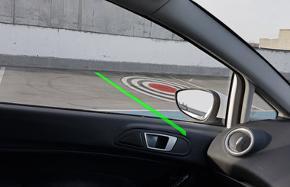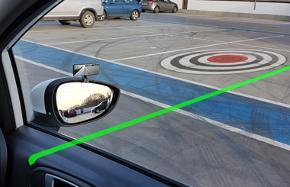Online driving tutorials
The second maneuver you should learn
Essentially, all the driving test manoeuvres are parking exercises. The forwards bay park is the easier of the two that take place in a car park. Students who over analyse the point of turn into the bay often struggle and make too much of it. Negotiating the car park itself, in my opinion, is the hardest bit.
Pick a bay, any bay, just not that one
The examiner will take you to a suitable car park, guide you around to a safe space and then stop you before giving further instructions. They'll tell you what you are about to do, ask you to pick any bay on either the left or the right. That you can't simply go straight into a by that directly in front of you. It needs to be a 90 degree type turn. They will tell you that you can't go across a bay to go into one behind it when the bays are back to back and that they want you to finish between the lines.
Once in they'll ask you to reverse out and to leave the car park.
Planning for bay parking is crucial. Think which side you want to park on and then position yourself on the other side of the aisle of the car park. For example, if the bay you want is on your right, you'll want to stay to the left. Being far over like this gives you more space to get the car in.
Parking on the right is far easier as you can see out of the window easier and keep the lines in view.
Think of this exercise like you're turning into a narrow street. You'd want to check your mirrors before turning the wheel for road users behind you, look at the bay and make the turn sharp. Avoid touching the first line of the bay you're entering. Clipping the second bay is OK as the car will come back in on itself.
A useful reference point here would be when the first line of the bay you want is inline with your door handle. I also get some students to imagine this green line connecting with their knees. Or some part of their leg depending on how close to the wheel they sit. This will be different for each driver as we all sit in different positions and are different heights.
Reference points for this aren't brilliant. It's quite a freestyle manouevre and requires good judgment.
Once half way in, little stops can be beneficial. It allows you to readjust your hands ready or unraveling the wheel. And allows you to think as to when to take off the turn. Use the information in front of you to decide when to straighten. When it looks like the front of the car is square with the wall, bush, fence etc in front of you, then take the turn off.
Apply the handbrake and put the car into neutral. Await further instructions on the manoeuvre.
You'll then be asked to leave the car park by the examiner.
Reversing makes it a manoeuvre
When ready, POM. Get the car into reverse, make sure you observe thoroughly, release the handbrake and slowly come back.
If there are empty bays on either side of you, you can turn immediately in the opposite direction of which you have been asked to leave. If there is a car on either or both sides of you, come back straight until your door mirrors have cleared the ends of the vehicles, then turn. This is prevent the bonnet hitting those parked vehicles.
The turn wants to be quick and shape to rapidly change direction. Once the bonnet is pretty much facing the direction you wish to go in, quickly take the turn off so that your wheels are facing the correct direction.
Stop. Apply the handbrake, go into first, observe your mirrors and around you before releasing the handbrake and carefully leave the car park.




